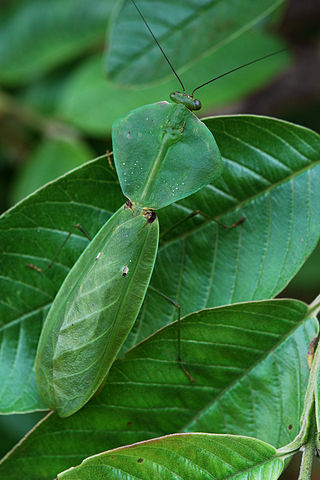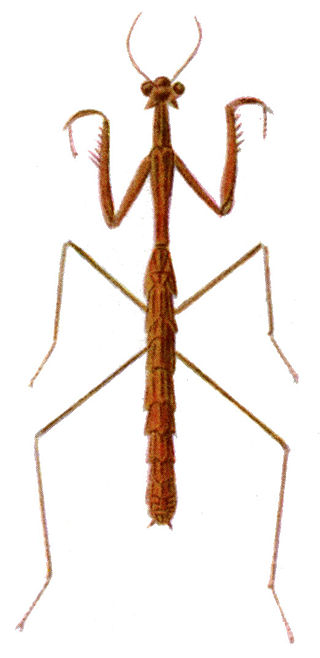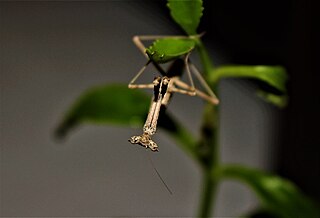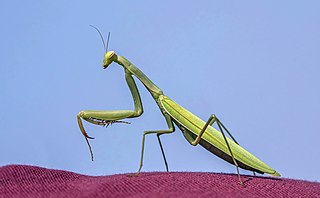
Mantis shrimp are carnivorous marine crustaceans of the order Stomatopoda. Stomatopods branched off from other members of the class Malacostraca around 340 million years ago. Mantis shrimp typically grow to around 10 cm (3.9 in) in length, while a few can reach up to 38 cm (15 in). A mantis shrimp's carapace covers only the rear part of the head and the first four segments of the thorax. Varieties range in colour from shades of brown to vivid colours, with more than 520 species of mantis shrimp known. They are among the most important predators in many shallow, tropical and subtropical marine habitats. However, despite being common, they are poorly understood, as many species spend most of their lives sheltering in burrows and holes.

Mantidae is one of the largest families in the order of praying mantises, based on the type species Mantis religiosa; however, most genera are tropical or subtropical. Historically, this was the only family in the order, and many references still use the term "mantid" to refer to any mantis. Technically, however, "mantid" refers only to members of the family Mantidae, and not the 14 remaining families of mantises. Some of the most recent classifications have promoted a number of the mantid subfamilies to the rank of family, e.g. Iridopterygidae, Sibyllidae, Tarachodidae, Thespidae, and Toxoderidae, while other classifications have reduced the number of subfamilies without elevating to higher rank.

Flower mantises are praying mantises that use a special form of camouflage referred to as aggressive mimicry, which they not only use to attract prey, but avoid predators as well. These insects have specific colorations and behaviors that mimic flowers in their surrounding habitats.

Choeradodis is a genus of praying mantises with common names such as shield mantis, hood mantis, and leaf mantis because of their extended, leaf-like thoraces. The distinguishing characteristic of Choreododis from which it takes its common names is a laterally expanded thorax. This adaptation for the purpose of camouflage, as well as a rounded wing case and a habit of staying relatively flattened, aid its leaf mimicry. Tiny liverworts, lichens and fungi have been found growing on the pronotum and wing case of many Choeradodis mantids; these appear to be opportunistic growths rather than an example of coevolution with the mantids to afford extra camouflage.

Phyllocrania paradoxa, common name ghost mantis, is a small species of mantis from Africa remarkable for its leaf-like body. It is one of the three species in the genus Phyllocrania. It is known for its distinct and exclusive camouflaged appearance of a dry weathered leaf.

Brunneria borealis, common name Brunner's mantis, Brunner's stick mantis, or northern grass mantis, is a species of praying mantis native to the southern United States. It is the only mantis species known to reproduce solely through parthenogenesis; there are no males.

Dead leaf mantis is a common name given to various species of praying mantis that mimic dead leaves. It is most often used in reference to species within genus Deroplatys because of their popularity as exotic pets. Examples include D. desiccata, D. lobata, and D. philippinica. Other species to which the term may apply include Acanthops falcataria, A. falcata, and Phyllocrania paradoxa.

Brunneria is a genus of praying mantises in family Mantidae. They are often called stick mantis for their slender shape and the species of the genus are native to the Americas.

Blepharopsis mendica is a species of praying mantis found in North Africa, parts of the Mediterranean, Middle East and southern Asia, and on the Canary Islands, and the sole member of the genus Blepharopsis. Egyptian flower mantis, thistle mantis, and Arab mantis are among its common names.
Aethalochroa ashmoliana, common name Iranian stick mantis, is a species of praying mantis found in India, Iran, Pakistan, and Sri Lanka.

Stick mantis and twig mantis are common names applied to numerous species of mantis that mimic sticks or twigs as camouflage. Often the name serves to identify entire genera such as is the case with:

African mantis and African praying mantis are common names for many species of praying mantis native to Africa.
Oxyothespis dumonti, common name North African grass mantis, is a species of praying mantis in the family Toxoderidae. It is found in Africa.

Sphodromantis gastrica, with the common names African mantis or common green mantis, is a species of praying mantis from Africa.

Sphodromantis is a large genus of praying mantises concentrated in Africa, sometimes considered a synonym of the genus Hierodula: from the same tribe, Paramantini. Outside their range especially, many share the common name African Mantis.
Boxer mantis is a common name given to various species of praying mantis. The name comes from the way these mantises move their oversized grasping forelimbs as they communicate with each other.

Oxyothespis is a genus of praying mantis in the family Toxoderidae. Members of this genus have been called grass mantises.

The bark mantises and ground mantises are praying mantids now placed in the family Eremiaphilidae that are native to the Afrotropics. They are generally light brown but more silvery on the wings. The wings are attractively reticulated, and the veins may be mottled dark and pale. The head is wider than the pronotum, which is rounded anteriorly, and doesn't overlap with the rear of the head. The pronotum is depressed, with its sides more or less parallel, and only a weak supra-coxal bulge is present. The anterior tibia are flattened and greatly expanded longitudinally, and the tibial claw does not fit into a pit between the 1st and 2nd external spines of the anterior femora, as in a few mantis groups.

Mantises are an order (Mantodea) of insects that contains over 2,400 species in about 460 genera in 33 families. The largest family is the Mantidae ("mantids"). Mantises are distributed worldwide in temperate and tropical habitats. They have triangular heads with bulging eyes supported on flexible necks. Their elongated bodies may or may not have wings, but all Mantodea have forelegs that are greatly enlarged and adapted for catching and gripping prey; their upright posture, while remaining stationary with forearms folded, has led to the common name praying mantis.













